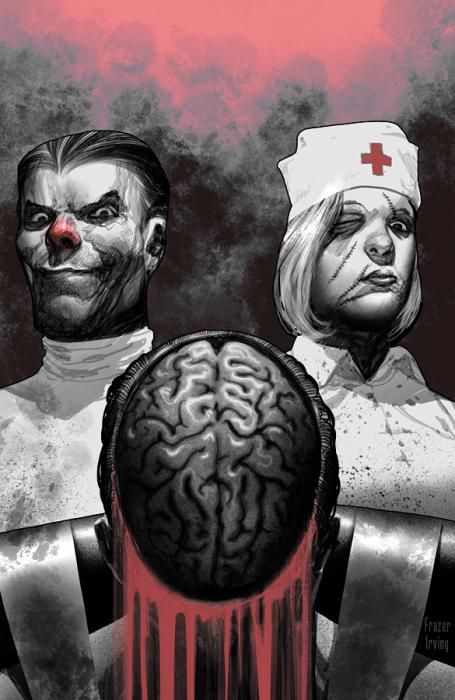"Bedlam" #4 takes Nick Spencer and Riley Rossmo's philosophical crime procedural series from good to great. "Bedlam" #1-3 was a fine debut and introduction to Madder Red/Fillmore Press and the city of Bedlam, but they relied heavily -- perhaps overly much -- on the main character's charisma and Spencer's central concept of a reformed serial killer. In a change from previous issues, "Bedlam" #4 is driven more by action than characterization. Instead of getting weaker when the spotlight moves off Fillmore Press, "Bedlam" grows stronger and more satisfying.
Spencer opens with yet another body. This fresh murder turns out to be the key to the Detective Acevado's case, although at the beginning of the story, she still labors under the misapprehension that Press is the killer. The timeline is linear and simple, but the plotting has the grace and suspense of a classic mystery. In particular, Spencer and Rossmo do a great job in the scene where Acevado questions the nun, where they let the reader feel the connections coming together in Acevado's mind, but save the content of her deductions until the next scene. "Bedlam" #4 reveals that Eric, the killer, has deeper motivations and this is the piece of the puzzle that makes the picture on the box suddenly come into focus.
Madder Red has been widely and aptly compared to The Joker, and correspondingly, the city of Bedlam also has a Batman-like superhero vigilante who works together with the police. More than once in "Bedlam" #4, I was reminded of Joss Whedon's "Dr. Horrible" or the animated movies "Despicable Me" and "Megamind." Although "Bedlam" is much darker, the underlying subversive (and funny) dynamic is the same: the un-athletic, socially-awkward, big-brained geek or nerd as the villainous protagonist facing a muscle-bound, goonish jock as the superheroic antagonist. The First has his heart in the right place, but he is also hilariously reliant on his fists.
In "Bedlam" #4, Rossmo is careful to emphasize this contrast in brains vs. muscle. Part of the subversive delight of "Bedlam" #4 is how Press is barely socially functional, but he proves that he has the chops "to help." A horizontal panel mid-issue places the svelte figure of Fillmore Press closer to Detective Acevado than the six-pack chest, biceps and caped costume of The First, perhaps foreshadowing the future alliance between Press and the police, in which he might prove to be more valuable than his old antagonist.
Despite all the twisted murders, the more I re-read "Bedlam: #4, the funnier it is. Press remains disturbingly sympathetic and likable. His speech patterns and his dynamic with other characters are still sources of comic gold, like when Press yells "Two to One! Tiebreaker! That clinches it!" Spencer's humor shows itself in other ways, too. When Acevado says matter-of-factly, "They're at the part I'm not legally allowed to witness," I hear Spencer's cynical wit.
Czuka's colors enhance the dark mood of "Bedlam" #4, especially in the scene in which he uses sickly contrasting purple and yellows to reinforce the alarm and nightmare-like urgency of a policeman's yelling face mirrored in The First's shiny helmet. Rossmo's near-silent closing sequence for "Bedlam" #4 is a soft cliffhanger, since Spencer has already revealed what happens. However, another detail about the killer's access to victims and Rossmo's slow pacing make this segment the creepiest part of "Bedlam" #4.
In the introductory arc for "Bedlam," Fillmore Press has yet to make contact with other killers in his newly-rehabilitated state, and the moment that he meets Eric, and perhaps sees his old self Madder Red in Eric's eyes, is the part of the denouement that I'm looking forward to the most.

